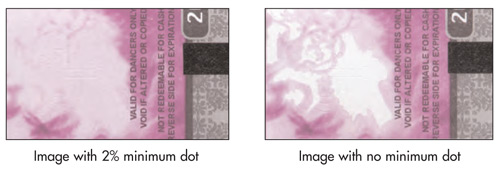If you are using QuarkXPress or InDesign, please collect your file! We also prefer you send a .pdf as an additional layout guide. Please include original artwork Dot Gain: Printing on thermal materials involves printing plates made out of a photo polymer. This material has a little flexibility to it unlike plates used in offset. The more pressure that is placed on the substrate the more ink lays down resulting in spread. This is an aspect of this type of printing that cannot be avoided. It is in the nature of
thermal printing. This kind of spread is called dot gain. It also happens in offset printing but is not nearly as apparent.
Lighter colors appear to have less gain than darker ones. You can expect to see a darker image if this is not
compensated for. Minimum Dot: Another consideration on design involves a minimum dot. Plates go through a scrubbing
process in order to leave the dots that will be printed in your design. Plates are created by exposing the polymer
material to light through the film which hardens the plate. That is followed by a chemical bath with brushes that
scrub away the areas not exposed to the light leaving your design. There is a 2% threshold of dots that will
completely disappear if they are implemented in the
design. Any color screened to lower than 2% will be
completely scrubbed off the printing plate and therefore
off of your design. This affects things like glows,
gradients, drop shadows, screened 4 color process
images and soft transitions from one color to another.
Dot gain in combination with this “drop out” results in
harsh transitions. See the example to the right.
4 Color Process vs. Spot Colors: Logos and art work in spot colors is the preferred format in which to
produce your tickets. Tickets using the Pantone Matching System using 100% color density are the only ones that
can be guaranteed a color match. Dot gain will affect screens and usually appears rough. Because of this,
Worldwide may mix an ink that matches a screen value of specified Pantone colors in your design. It produces a
better looking ticket for you.
Screen vs. Solid: Screens are not made up of a lightening of the ink but rather dots that allow the substrate color to show in between them. So 20% color is a 100% ink on dots that cover 20% of the surface. Any screen whether in 4 color process or a Pms color is subject to dot gain, which adds ink to the edge of the dots and adds to the perception of more coverage. Solid ink coverage or 100% coverage is the only way that can guarantee a color match. Vector vs. Raster: Pixels (Raster) make up photos and most files produced in image editing programs. Vector files are typically logos, line art and text. These are files generated using mathematics to calculate shapes colors and forms. Vector files are almost always more efficient and create sharp lines for your artwork making this format the choice when at all possible. Providing logos and text from an image editor can result in fuzzy edges along any lines that should be crisp. If you only have access to Raster images for your logos, please supply the file at the highest resolution possible. This will give us a good starting point from which to produce your job. File formats: Worldwide accepts a wide range of formats, including psd, photoshop eps, tiff, bmp, jpg, ai,
vector eps. We will try to work with what you provide and will advise you of any issues arising in your job. Images
in Word documents and Publisher files may or may not work. These programs are not graphic standards and
results are often unexpected. Plate Gap: There is a 1/16th of an inch space on the right side of every other ticket. This is caused by the plates that wrap around the printing cylinder where the thickness of the plate causes the printing surface to spread out. So when you wrap the plate around the cylinder and the edges meet, you will still have a space where the printing surface will not. You can take into account for this in your layout by not allowing your artwork to extend all the way horizontally to both ends of you ticket design. Layouts with borders and images that extend across the entire surface will be affected. Sponsors: You can spread sponsors across as many tickets as there are on the plate. A typical 2 x 5.5 inch ticket will run with 10 repeat images in the printing plate, therefore you can run 10 separate sponsors (one in each spot). You can also run combinations of ads depending on your sponsorship needs. See the example below or talk to your sales representative for more information.
|
|
|
Single Ticket & Season Book Artwork Specifications Seating Chart Specs and Formats |


